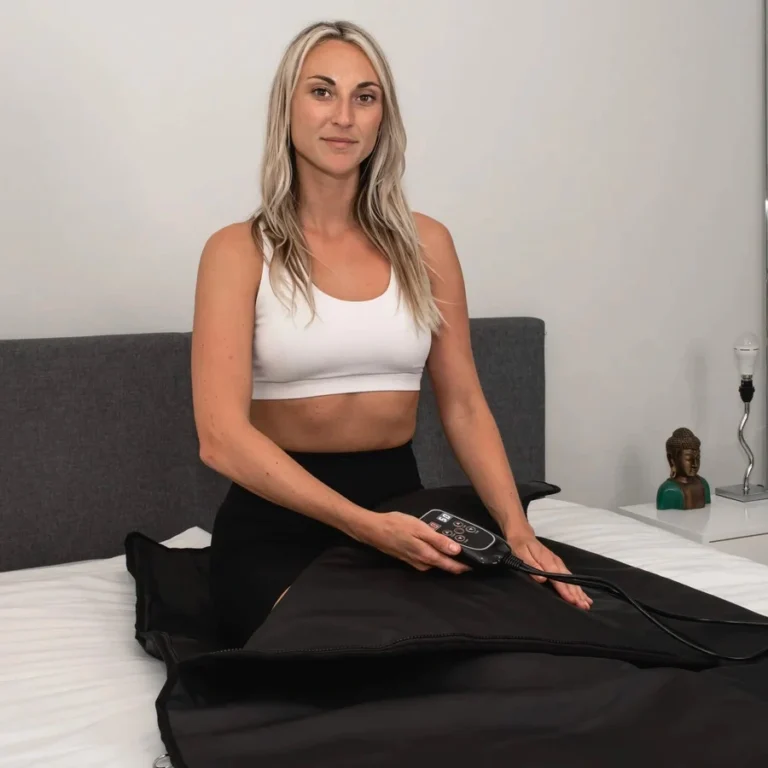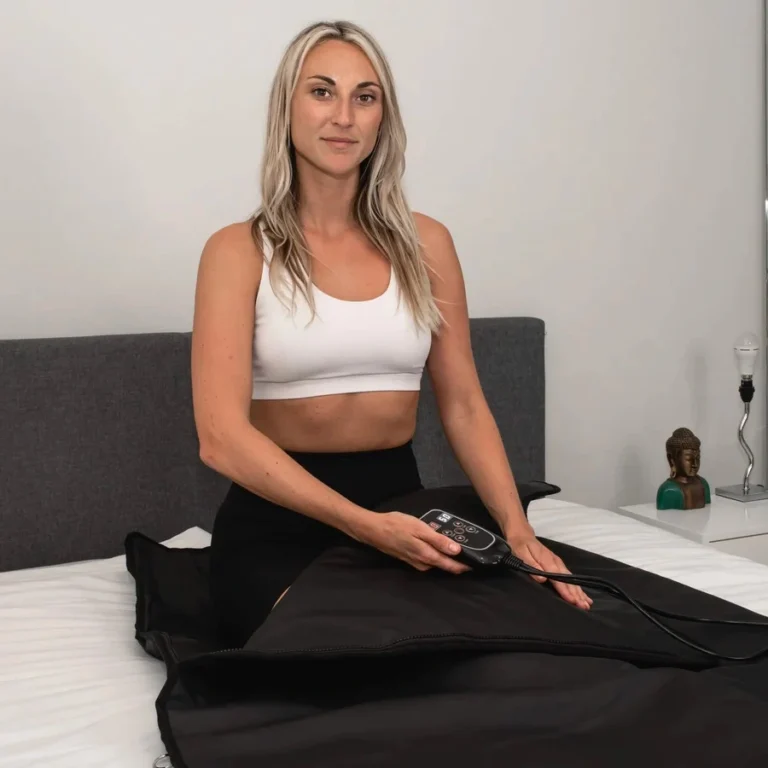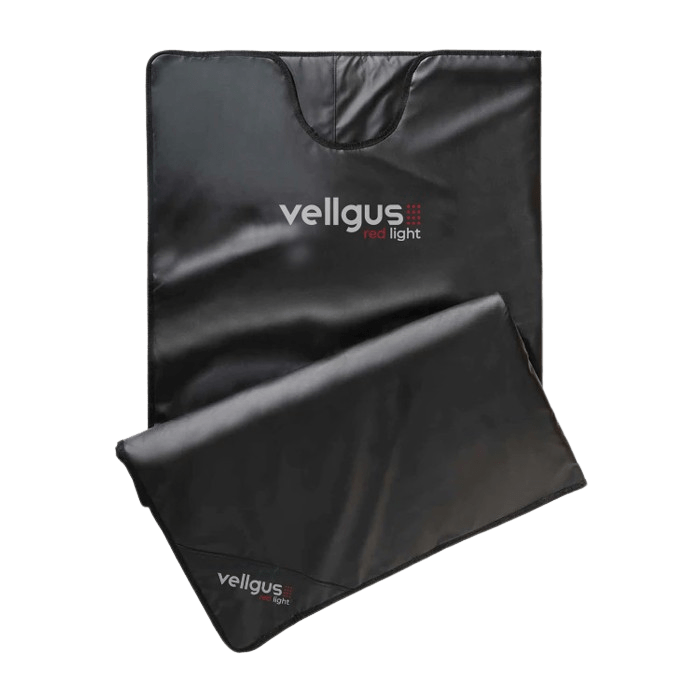In recent years, infrared sauna blankets have gained significant popularity as a convenient, at-home wellness solution. These portable alternatives to traditional saunas promise many of the same benefits while addressing space constraints and accessibility issues that come with full-sized sauna installations. This comprehensive guide explores the science behind infrared sauna blankets, their potential health benefits, possible disadvantages, and practical considerations to help you determine if these innovative wellness products are right for you.
Table of Contents
What Is an Infrared Sauna Blanket?
An infrared sauna blanket is a portable wellness device that uses far-infrared technology to create a sauna-like experience in the comfort of your own home. Unlike traditional saunas that heat the air around you, infrared sauna blankets use infrared radiation to directly heat your body. These blankets typically resemble sleeping bags or body wraps that you can lie in while the infrared heating elements warm your body from within.
The technology behind infrared sauna blankets involves far-infrared radiation (FIR), a type of energy on the electromagnetic spectrum that our bodies experience as heat. These rays penetrate the skin more deeply than the heat from traditional saunas, potentially offering unique benefits while operating at lower, more comfortable temperatures (typically between 110-140°F compared to 150-195°F in traditional saunas).
The Science Behind Infrared Sauna Blankets
To understand the potential benefits and limitations of infrared sauna blankets, it’s important to grasp the underlying science:
Far-Infrared Technology
Far-infrared radiation represents a specific portion of the infrared spectrum with wavelengths between 5.6 and 1000 micrometers. This radiation is naturally emitted by the sun and by our own bodies. Far-infrared waves can penetrate up to 1.5 inches beneath the skin’s surface, interacting with water molecules and organic compounds in our tissues.
When far-infrared radiation contacts the skin, it causes water molecules in our tissues to vibrate. This molecular movement generates heat through a process called resonant absorption, increasing local tissue temperature and promoting increased blood circulation to the area.
Heat Shock Proteins and Hormetic Response
One of the key physiological responses to infrared sauna use involves the production of heat shock proteins (HSPs). These protective proteins are activated when cells are exposed to stressors like heat. HSPs help repair damaged proteins, protect cells from stress, and can trigger beneficial adaptations throughout the body.
This process exemplifies hormesis—the biological principle where moderate exposure to a stressor can produce beneficial adaptive responses that improve overall resilience and health. Regular infrared sauna sessions may help optimize this hormetic response, potentially contributing to various health benefits.
Potential Benefits of Infrared Sauna Blankets
Infrared sauna blankets have been associated with numerous potential health benefits. While research specifically on blankets is still emerging, many benefits are likely similar to those documented with traditional infrared saunas. Here are the most notable potential advantages:
1. Enhanced Recovery and Reduced Muscle Soreness
Athletes and fitness enthusiasts often turn to infrared sauna blankets to aid recovery after intense physical activity. The deep-penetrating heat may help:
- Increase blood flow to muscles, potentially accelerating recovery
- Reduce delayed onset muscle soreness (DOMS)
- Relax muscle tension and improve flexibility
- Facilitate the removal of metabolic waste products
A 2015 study published in the Journal of Athletic Enhancement found that infrared sauna use after strength training sessions helped reduce muscle soreness and accelerate strength recovery compared to passive recovery methods.
2. Detoxification Support
While “detoxification” claims require nuanced understanding, infrared sauna blankets may support the body’s natural elimination processes through increased sweating. During an infrared sauna blanket session, you may experience:
- Profuse sweating that can help eliminate certain heavy metals and environmental toxins through the skin
- Support for the body’s natural detoxification pathways
- Potential reduction in toxic burden over time with regular use
A study published in the Archives of Environmental Health demonstrated that regular sauna use helped increase elimination of heavy metals like mercury, lead, and cadmium through sweat. However, it’s important to note that the primary organs of detoxification remain the liver and kidneys.
3. Cardiovascular Benefits
Regular use of infrared sauna blankets may contribute to cardiovascular health through several mechanisms:
- Increased heart rate (similar to moderate exercise)
- Improved vasodilation and blood flow
- Potential reduction in blood pressure over time
- Enhanced cardiovascular conditioning
Research published in the Journal of the American Medical Association has shown that regular sauna use is associated with reduced risk of cardiovascular events and all-cause mortality. While these studies focused on traditional Finnish saunas, the heat stress response mechanisms may apply to infrared applications as well.
4. Stress Reduction and Improved Sleep
Many users report significant stress-reduction benefits from regular infrared sauna blanket sessions:
- Activation of the parasympathetic nervous system (rest and digest mode)
- Reduced cortisol levels following regular use
- Improved sleep quality and duration
- General feelings of relaxation and wellbeing
The deep relaxation induced by the gentle, penetrating heat may help address stress-related issues that affect millions. A small study published in Complementary Therapies in Medicine found that infrared sauna sessions helped improve sleep patterns in participants with chronic fatigue syndrome.
5. Skin Health and Appearance
The profuse sweating induced by infrared sauna blankets may benefit skin health:
- Deep cleansing of pores through sweating
- Increased circulation to skin tissues
- Potential collagen production stimulation
- Improved skin tone and texture over time
Increased blood flow to the skin delivers more nutrients and oxygen while helping remove waste products, potentially contributing to a healthier complexion. Some users report improvements in skin conditions like acne, though clinical evidence specifically for infrared sauna blankets is limited.
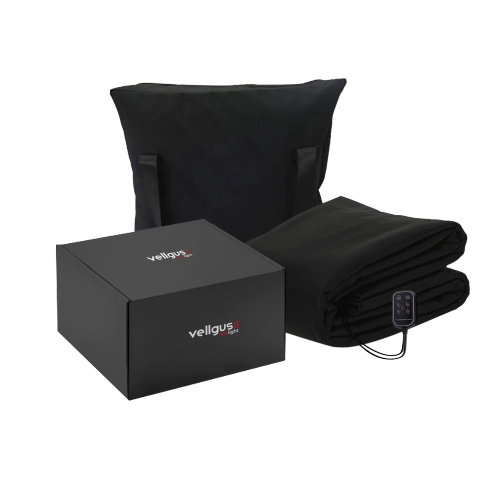
6. Pain Management
For those suffering from various types of pain, infrared sauna blankets may offer relief:
- Reduced joint stiffness and discomfort
- Temporary relief from arthritis symptoms
- Decreased muscle tension
- Improved circulation to painful areas
A clinical trial published in Clinical Rheumatology found that infrared sauna therapy helped reduce pain and improve quality of life in patients with rheumatoid arthritis and ankylosing spondylitis.
7. Convenience and Accessibility
Beyond physiological benefits, infrared sauna blankets offer practical advantages:
- Space-saving alternative to traditional saunas
- More affordable than built-in sauna installations
- Portability for use while traveling
- Energy efficiency compared to heating an entire sauna room
- Privacy of use in your own home
For many urban dwellers or those with limited space, an infrared sauna blanket provides access to sauna benefits that might otherwise be inaccessible or inconvenient.
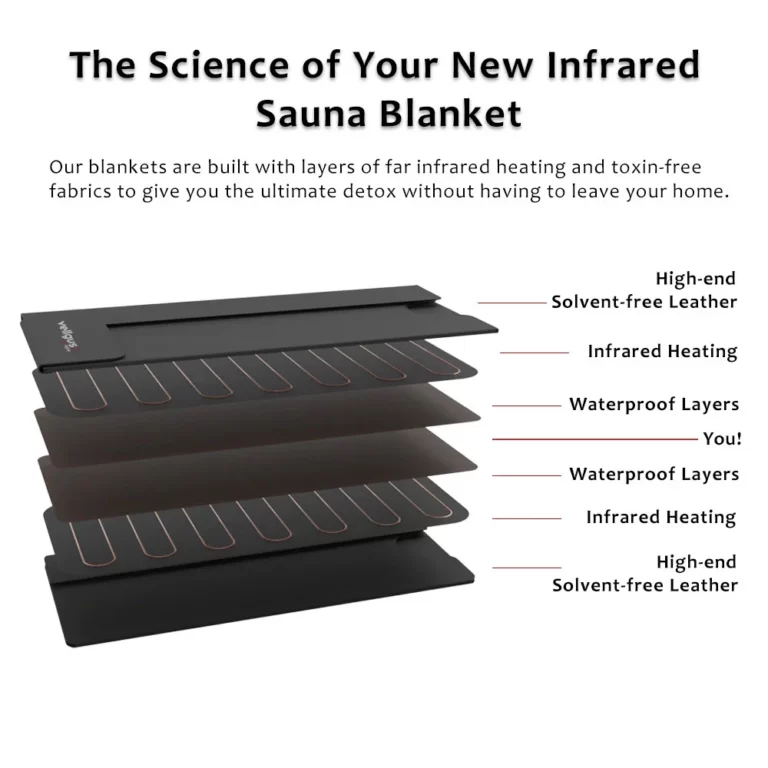
Potential Disadvantages and Limitations
While infrared sauna blankets offer many potential benefits, they also come with several disadvantages and limitations that prospective users should consider:
1. Limited Scientific Research
Perhaps the most significant drawback is the relatively limited body of scientific research specifically examining infrared sauna blankets:
- Most research focuses on traditional saunas or infrared sauna rooms
- Limited long-term studies on regular infrared sauna blanket use
- Variable quality in available commercial products and their effectiveness
- Potential publication bias favoring positive results
While many benefits can reasonably be extrapolated from studies on infrared saunas generally, more research specifically on blanket formats is needed.
2. Heat Distribution and Experience Limitations
The experience of using an infrared sauna blanket differs significantly from traditional saunas:
- Potential for uneven heat distribution compared to room saunas
- Limited movement while inside the blanket
- Less immersive experience than traditional sauna rooms
- Possible discomfort from lying in one position
- Face typically remains outside the blanket
Some users may find the enclosed feeling claustrophobic or restrictive compared to sitting in a traditional sauna space.
3. Safety Concerns
Several safety considerations come with infrared sauna blanket use:
- Risk of overheating or dehydration if used improperly
- Potential for burns if the device malfunctions
- Electromagnetic field (EMF) exposure concerns with some models
- Contraindications for certain medical conditions
- Potential interactions with medications that affect heat tolerance
While quality products have safety features, not all brands maintain the same standards, and user error can contribute to adverse experiences.
4. Contraindications for Certain Individuals
Infrared sauna blankets are not appropriate for everyone. They may be contraindicated for people with:
- Pregnancy
- Cardiovascular conditions like uncontrolled hypertension
- Multiple sclerosis or other heat-sensitive conditions
- Hemophilia or bleeding disorders
- Fever or active infections
- Certain skin conditions that might be aggravated by heat
- Recent joint injuries or acute inflammation
- Implanted medical devices (consult healthcare provider)
Always consult with a healthcare provider before beginning infrared sauna blanket use if you have any medical conditions or concerns.
5. Maintenance and Hygiene Challenges
Keeping an infrared sauna blanket clean and properly maintained presents challenges:
- Sweat accumulation requiring frequent cleaning
- Material degradation over time from heat and moisture
- Difficulty thoroughly cleaning internal components
- Potential for mold or bacterial growth if not properly dried
- Limited lifespan compared to traditional saunas
Most manufacturers recommend wearing lightweight clothing inside the blanket to improve hygiene, but this doesn’t eliminate the need for regular cleaning.
6. Initial Investment and Ongoing Costs
While less expensive than full saunas, infrared sauna blankets still represent a significant investment:
- Quality models typically cost between $300-$700
- Potential additional electricity costs for regular use
- Replacement costs if components fail outside warranty periods
- Accessories like waterproof liners add to overall expense
Lower-priced models may save money initially but often come with shorter lifespans, less effective heating, or higher EMF levels.
How to Choose an Infrared Sauna Blanket
When selecting an infrared sauna blanket, consider these important factors:
1. EMF Levels
Electromagnetic field exposure is a concern for many users. Look for:
- Low-EMF certified products
- Third-party testing documentation
- Brands that specifically address EMF shielding
2. Materials and Construction
The materials used affect both safety and experience:
- Non-toxic, heat-resistant outer materials
- Waterproof or water-resistant inner liners
- Quality heating elements with even distribution
- Multiple heat settings for customization
3. Temperature Range and Controls
Effective temperature control is essential:
- Wide temperature range (typically 95-165°F)
- Precise digital controls
- Auto-shutoff safety features
- Timer functions
4. Size and Fit
Finding the right dimensions ensures comfort:
- Length accommodating your height
- Sufficient width for comfortable movement
- Adjustable closure systems
- Weight that feels secure but not restrictive
5. Warranty and Customer Support
Protection for your investment matters:
- Minimum 1-year warranty (2+ years preferred)
- Responsive customer service
- Clear return policies
- Available replacement parts
Best Practices for Using an Infrared Sauna Blanket
To maximize benefits and minimize risks, follow these guidelines when using an infrared sauna blanket:
1. Hydration
Proper hydration is critical:
- Drink 16-20 oz of water before your session
- Keep water nearby during use
- Rehydrate after your session
- Consider electrolyte replacement for longer sessions
2. Session Duration and Frequency
Start conservatively and gradually increase:
- Begin with 15-20 minute sessions
- Build up to 30-45 minutes as tolerated
- 2-4 sessions per week is typical for most users
- Allow recovery days between sessions
3. Clothing and Hygiene
Proper attire improves both comfort and cleanliness:
- Wear lightweight, absorbent clothing
- Cotton garments are generally recommended
- Consider using a towel inside the blanket
- Shower before and after sessions
4. Monitoring Your Response
Pay attention to how your body responds:
- Exit immediately if you feel dizzy, nauseated, or extremely uncomfortable
- Note changes in energy, sleep, and recovery over time
- Adjust session length and temperature based on personal response
- Consult a healthcare provider if you experience concerning symptoms
Who Should Avoid Infrared Sauna Blankets
While many can benefit from infrared sauna blankets, certain groups should exercise caution or avoid them entirely:
- Pregnant women
- Children
- Elderly individuals with heat sensitivity
- People with cardiovascular disease
- Individuals with implanted medical devices
- Those with acute injuries or inflammation
- People taking medications that affect heat tolerance
- Individuals with certain skin conditions
If you belong to any of these groups, consult with a healthcare provider before using an infrared sauna blanket.
Comparing Infrared Sauna Blankets to Alternatives
Understanding how infrared sauna blankets compare to alternatives helps in making an informed decision:
Traditional Saunas
- Higher temperatures (150-195°F vs. 110-140°F)
- Heats air rather than directly heating body
- Requires dedicated space
- Higher upfront costs but potentially longer lifespan
- More immersive experience
Steam Rooms
- Uses moist heat rather than dry heat
- May benefit respiratory conditions
- Requires plumbing and dedicated space
- Different physiological response than infrared heat
- Higher maintenance requirements
Full Infrared Sauna Cabins
- Similar technology but in cabin form
- Allows sitting rather than lying down
- More space for movement
- Higher cost and space requirements
- Often allows for multi-person use
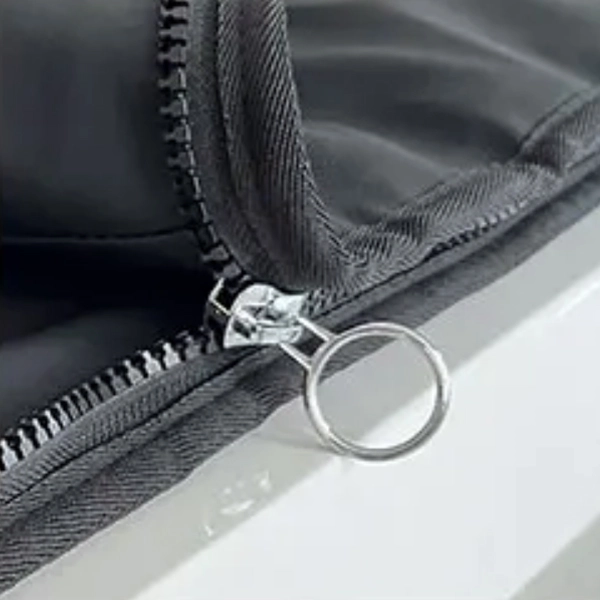
Conclusion: Are Infrared Sauna Blankets Worth It?
Infrared sauna blankets represent an innovative approach to bringing sauna benefits into the home in a more accessible format. For many users, they offer a valuable addition to wellness routines, potentially supporting recovery, relaxation, and overall wellbeing.
Whether an infrared sauna blanket is worth the investment depends on your personal circumstances, wellness goals, and health status. Consider the following factors when making your decision:
- Available space in your home
- Budget constraints
- Specific health goals
- Frequency of intended use
- Personal comfort with the blanket format
For those seeking the benefits of sauna therapy without the space requirements or expense of traditional installations, infrared sauna blankets offer a compelling option. However, they should be viewed as a complement to, rather than a replacement for, other healthy lifestyle practices.
As with any wellness tool, results vary between individuals, and the benefits accrue primarily through consistent, appropriate use over time. By understanding both the potential advantages and limitations of infrared sauna blankets, you can make an informed decision about whether this innovative wellness technology deserves a place in your health routine.
Remember to consult with a healthcare provider before beginning regular infrared sauna blanket use, particularly if you have any existing health conditions or concerns. With proper precautions and realistic expectations, an infrared sauna blanket may become a valuable addition to your personal wellness toolkit.

